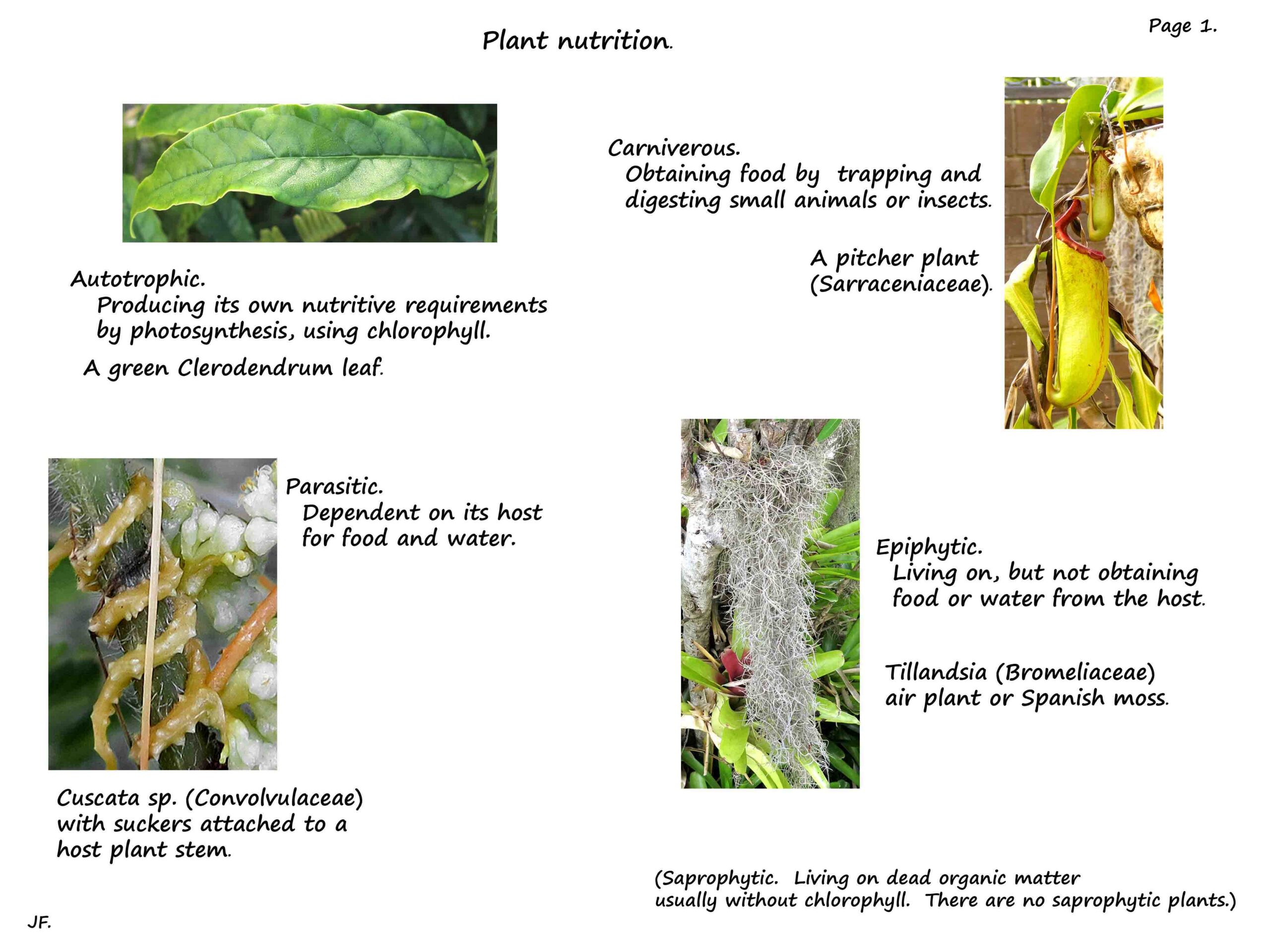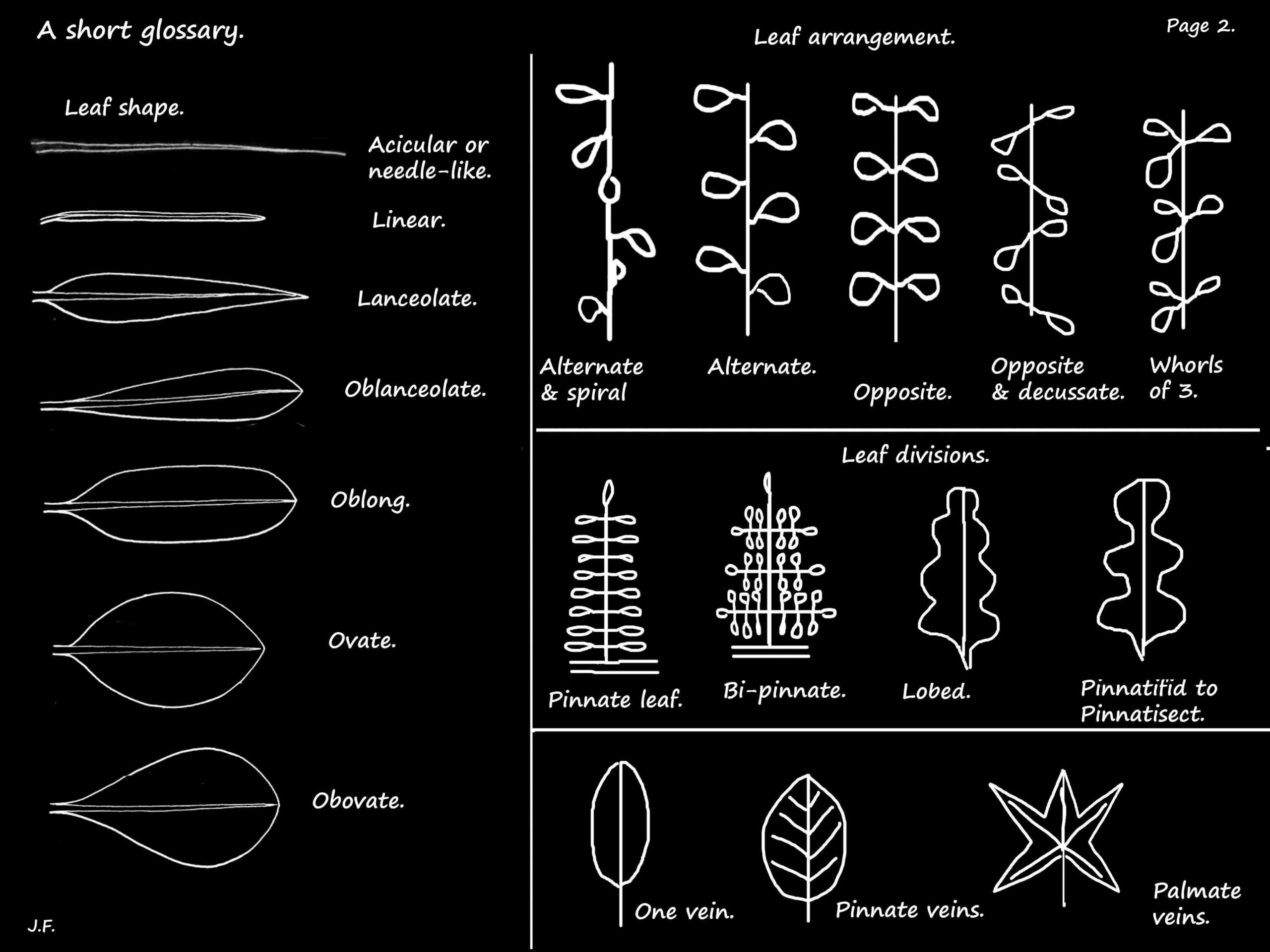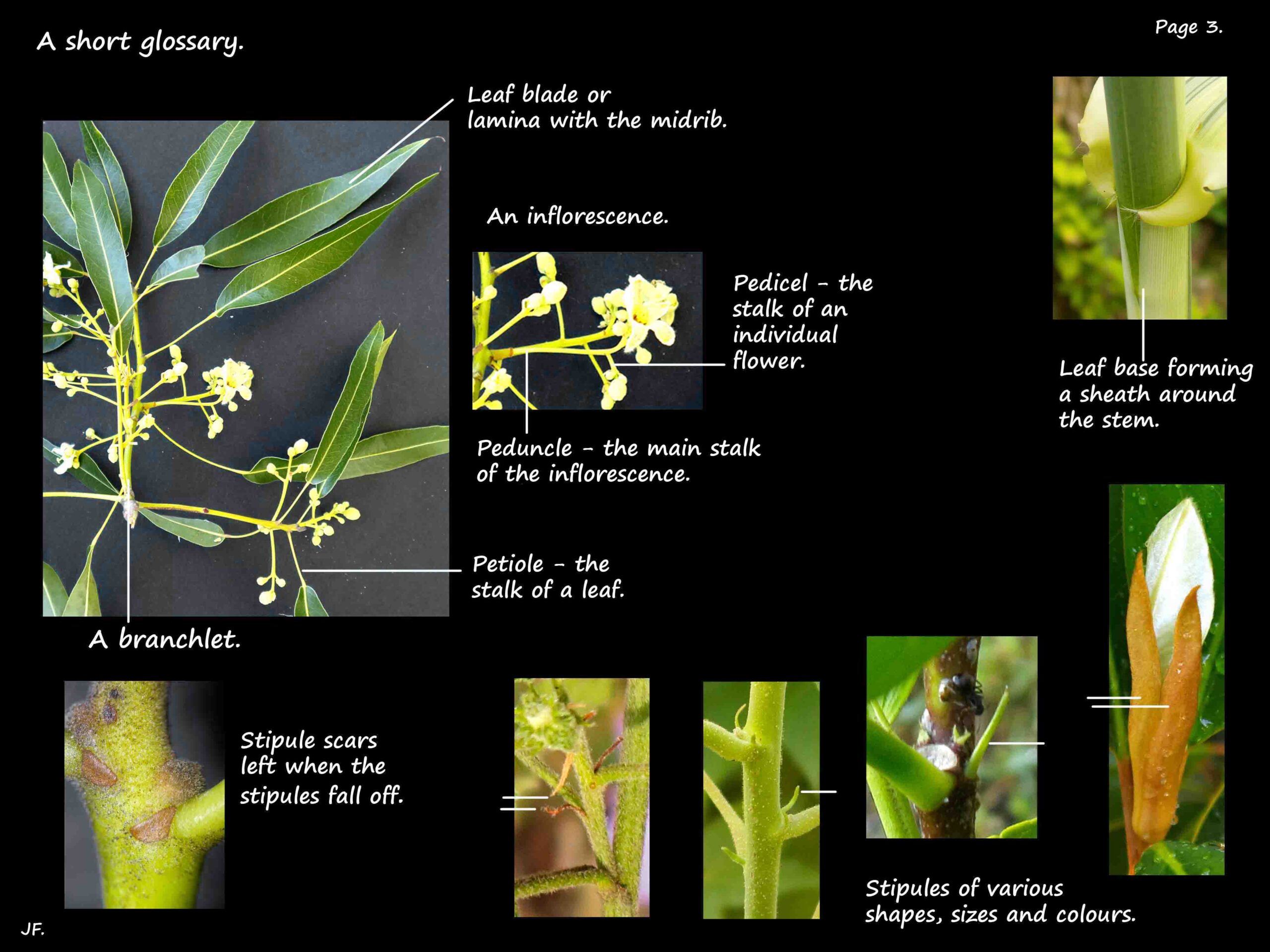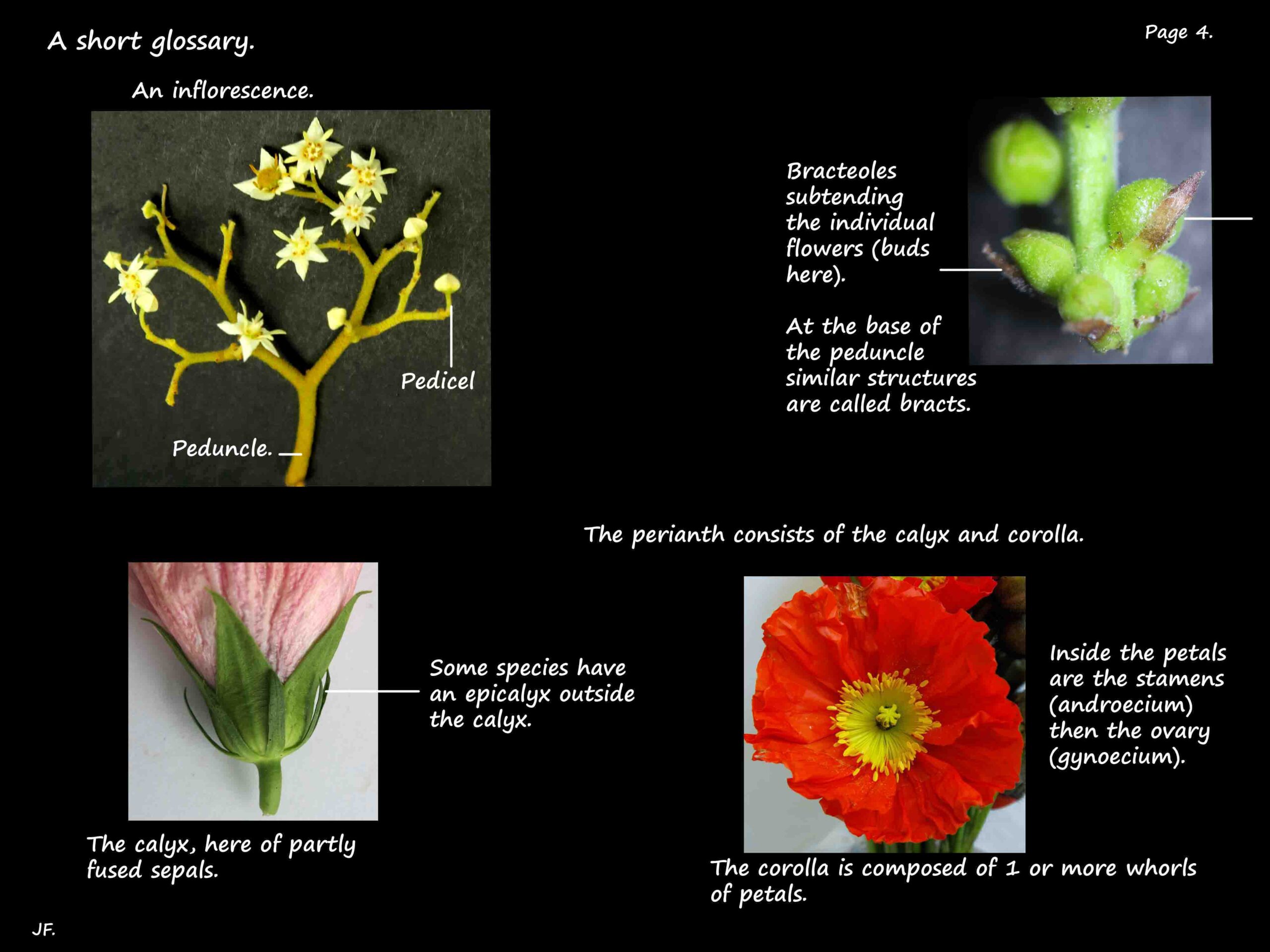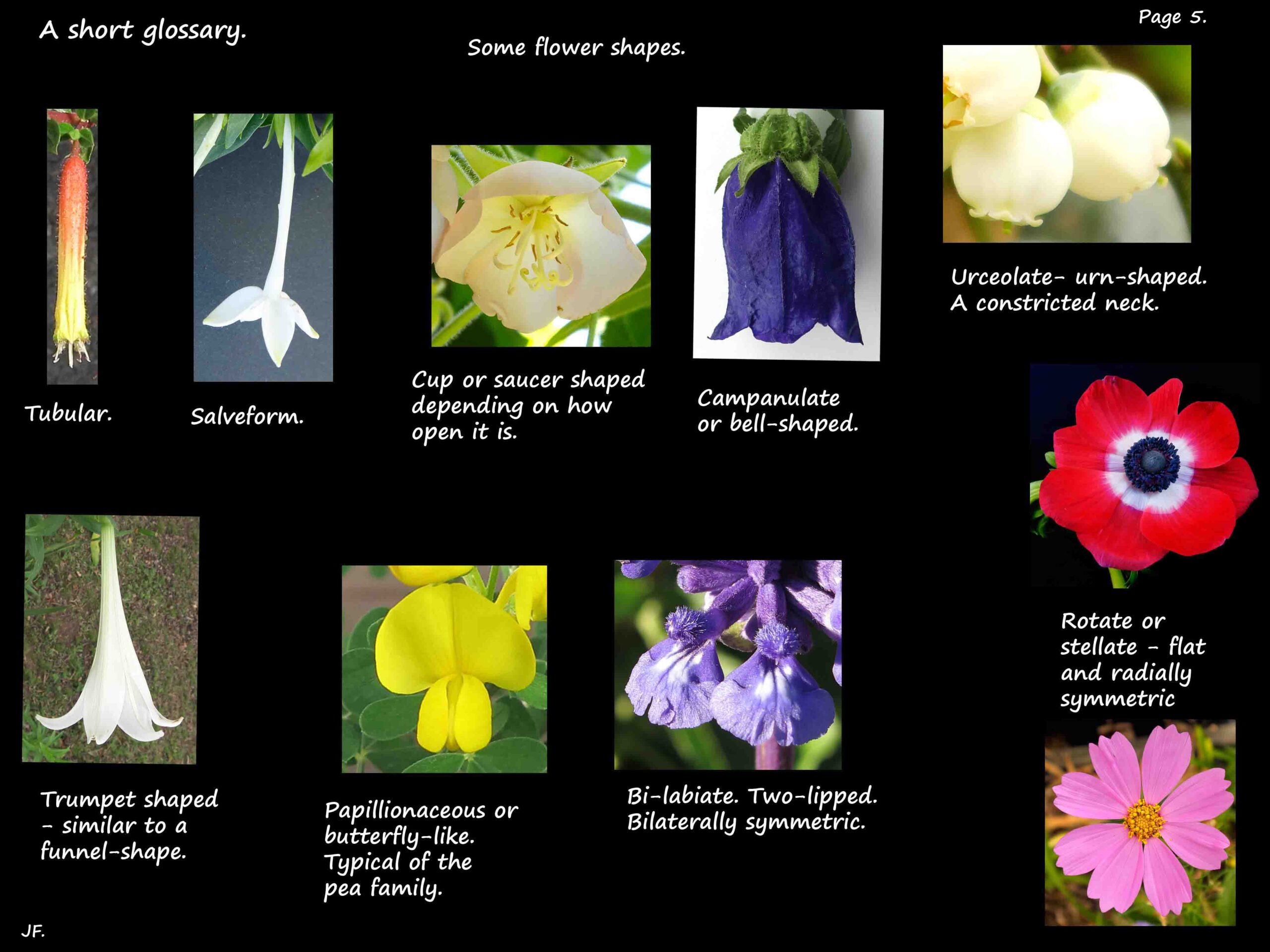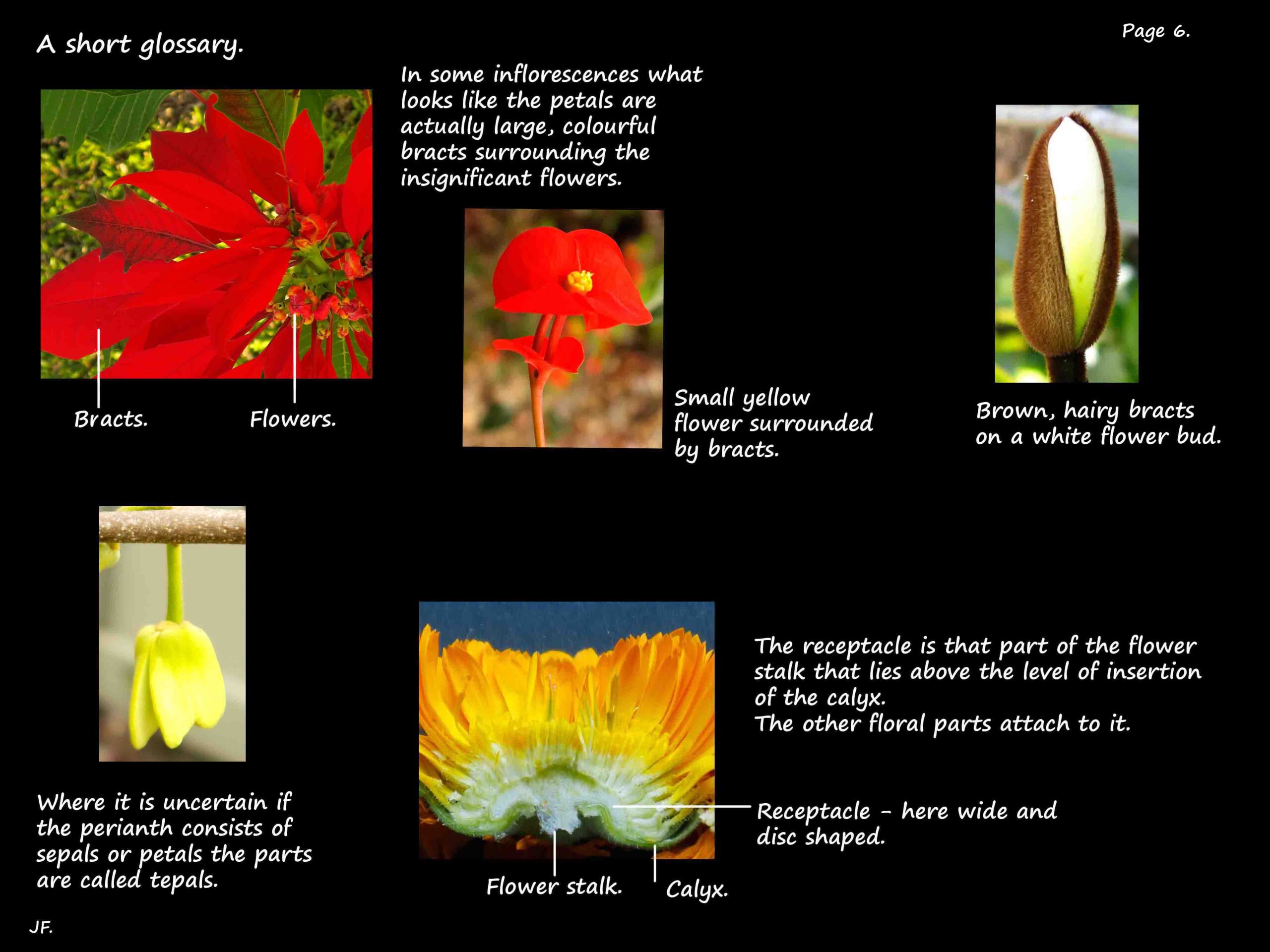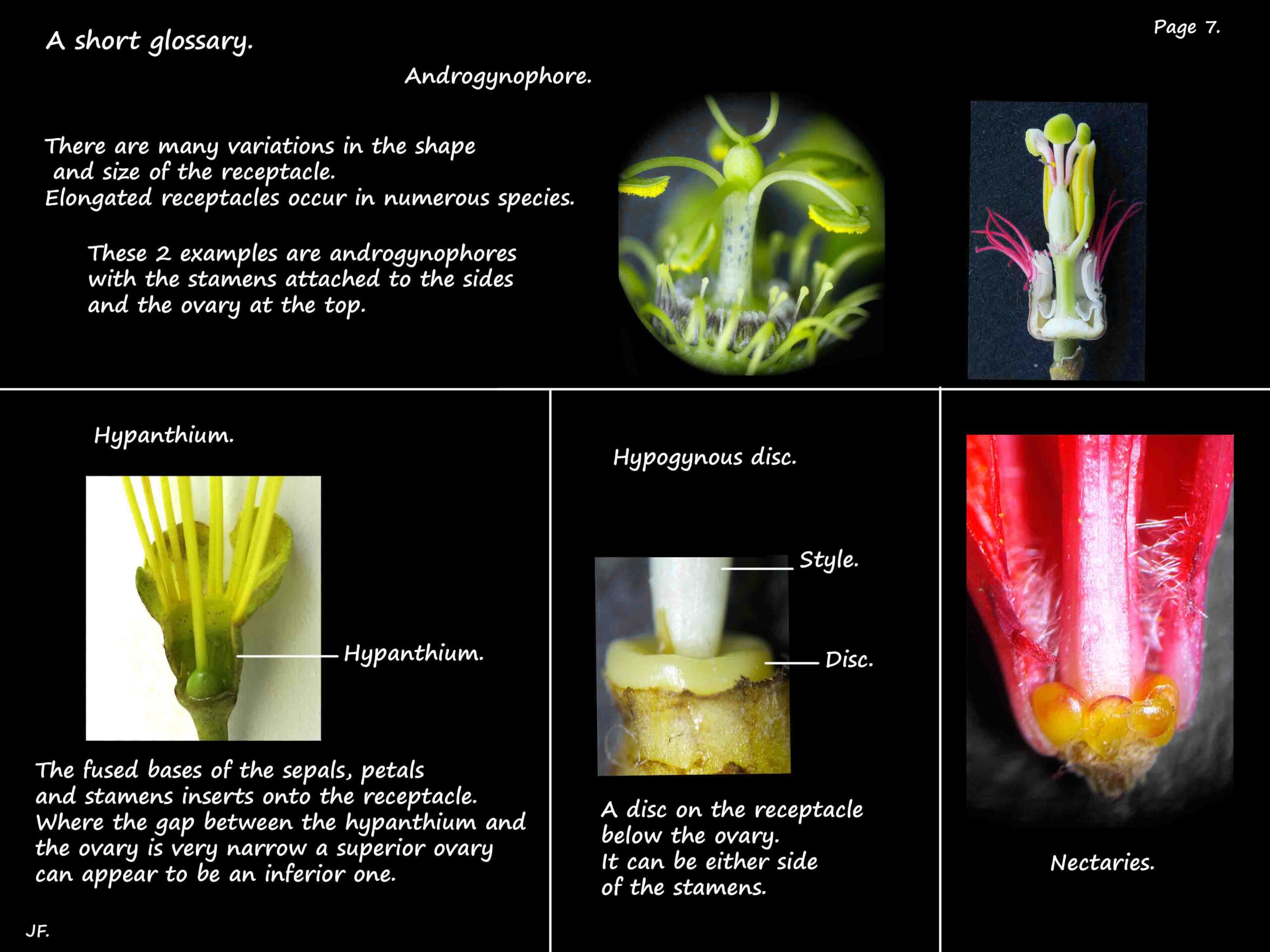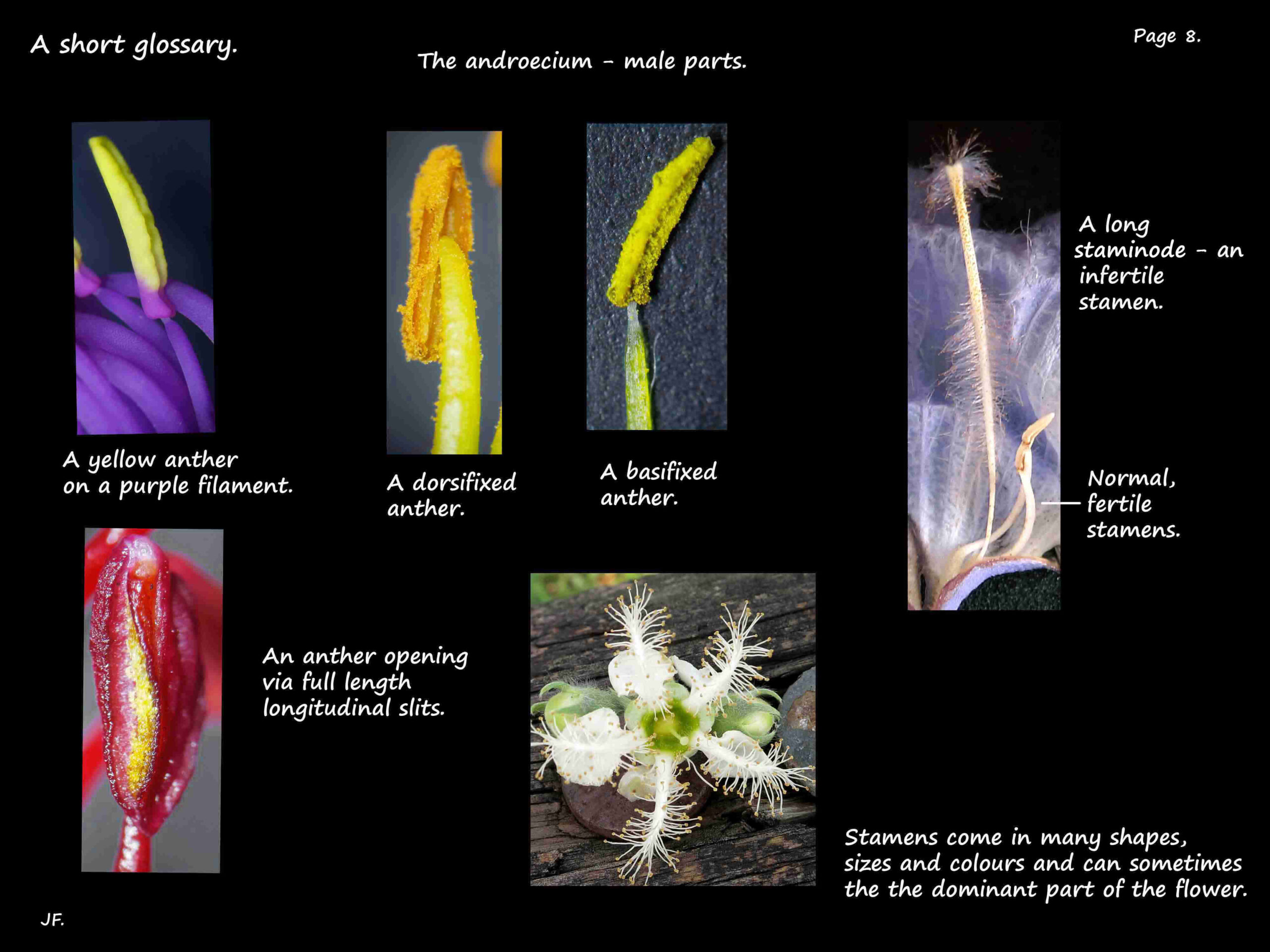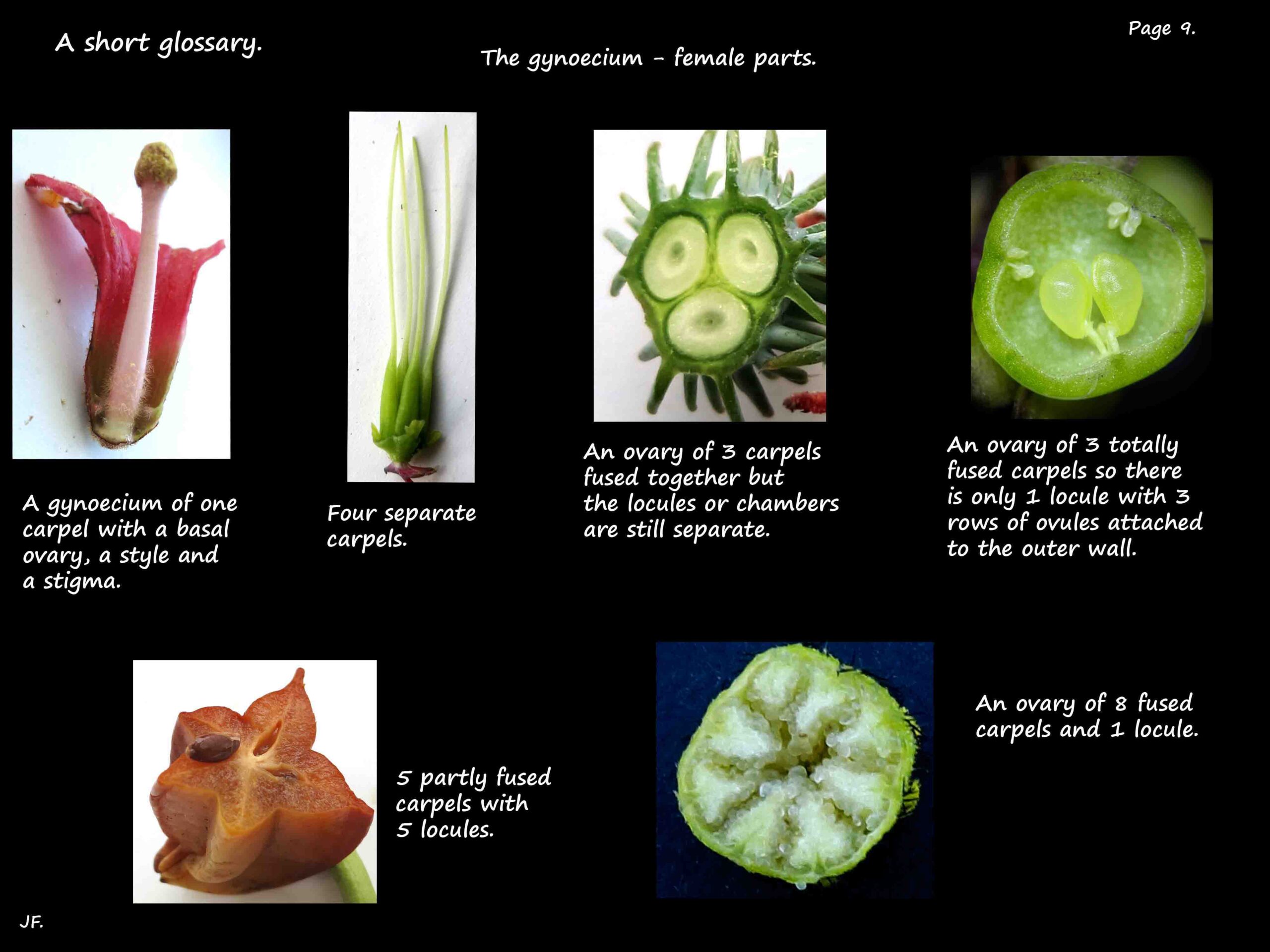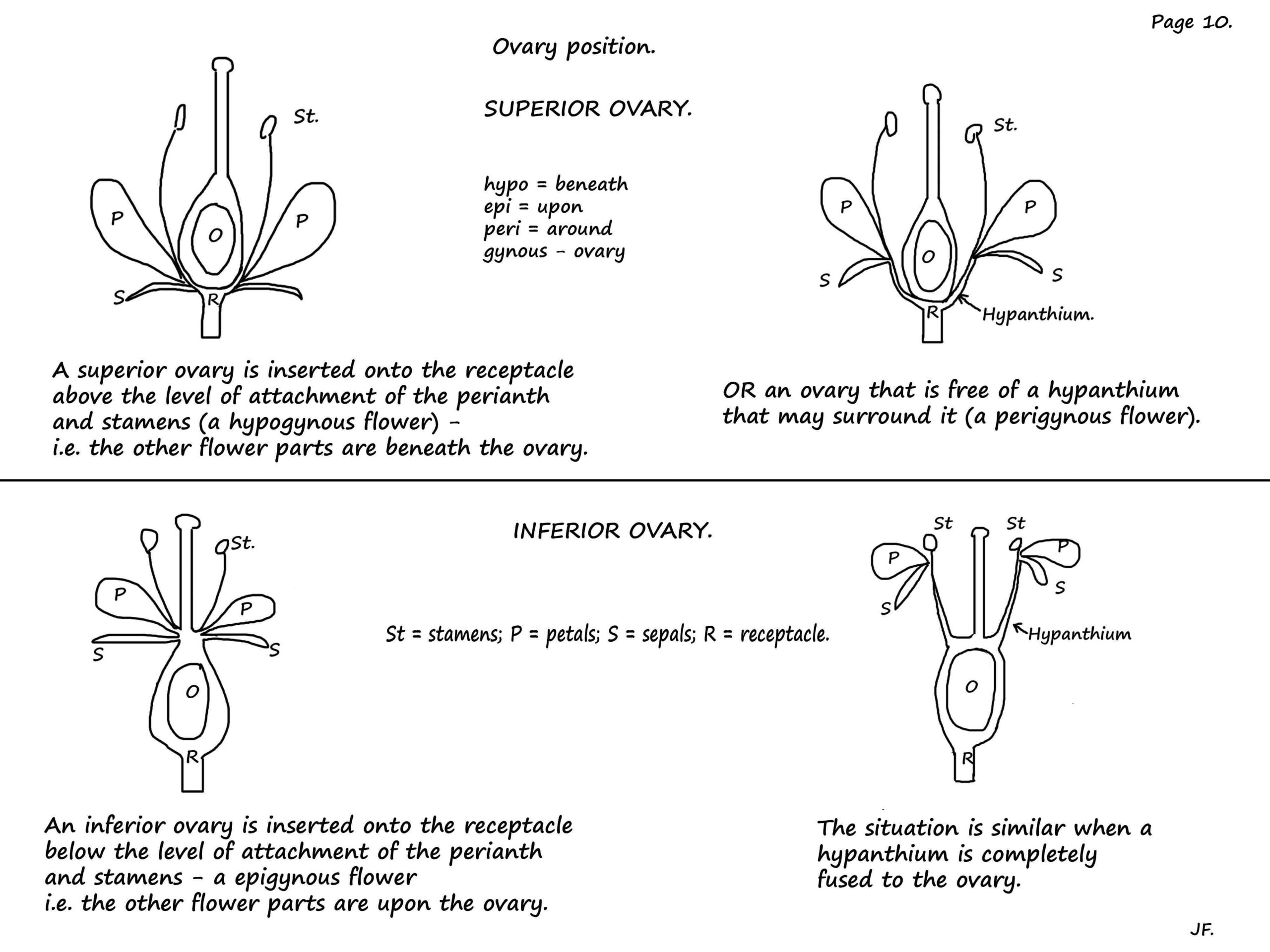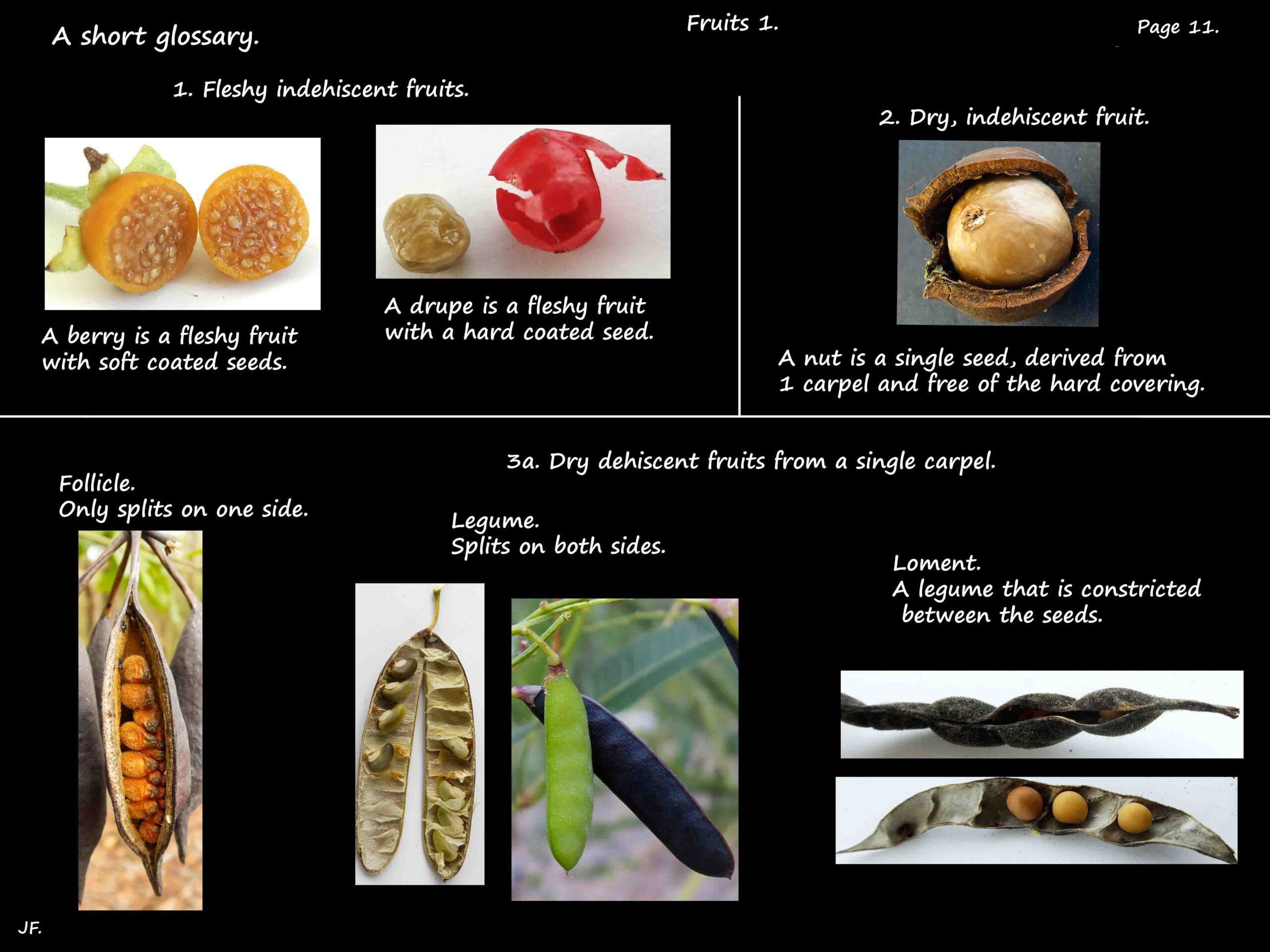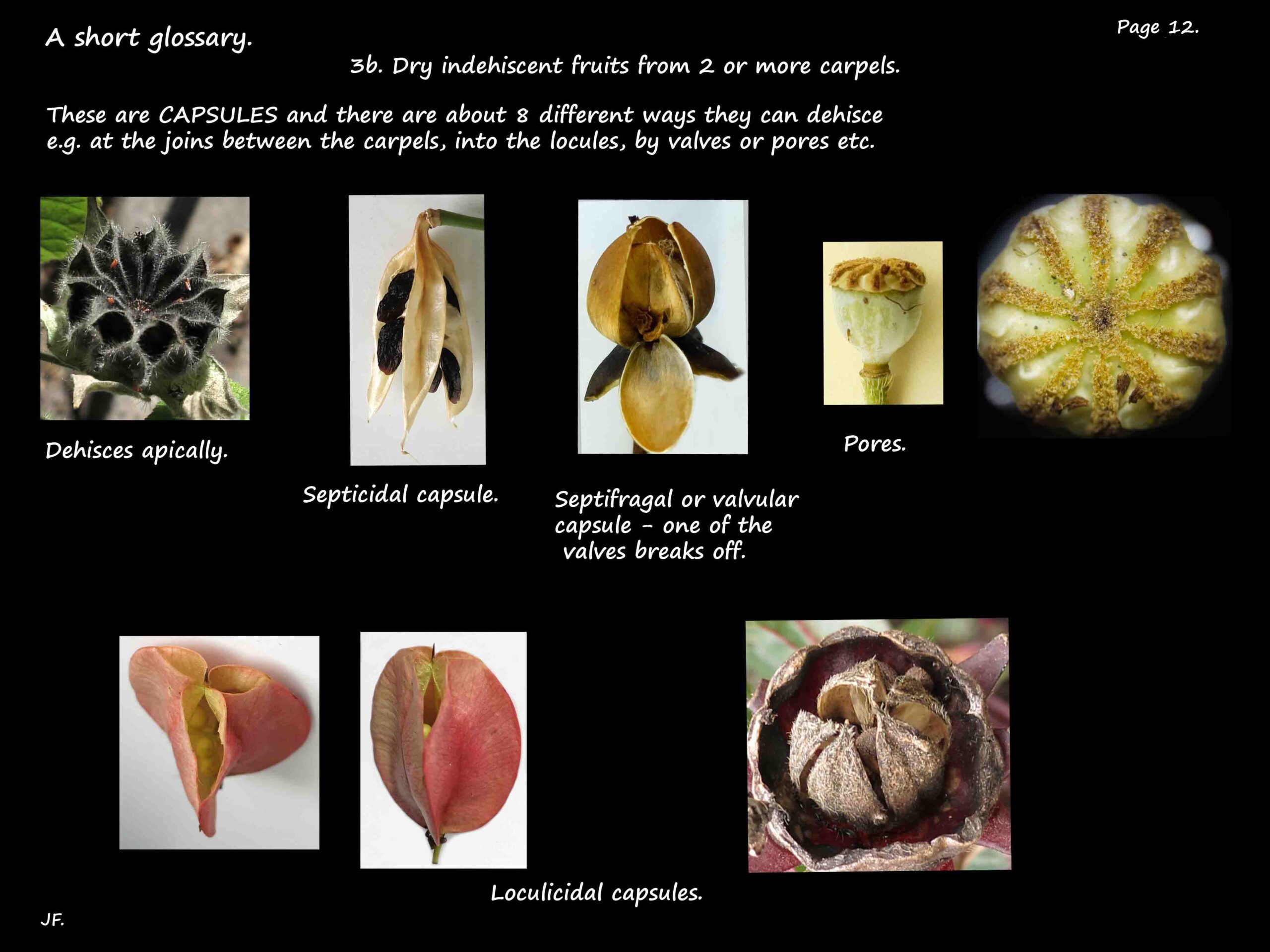A short plant glossary
Plant glossary.
This only covers a few of the most commonly used terms some of which are illustrated on the following pages.
Many other terms will be explained in describing actual specimens.
Miscellaneous terms.
Epiphytic – growing on another plant but not using it for nutrition.
Herb – a plant with non-woody stems, either annual, biennial or perennial.
Indigenous – native to a particular place.
Liana (Liane) is a woody vine.
Naturalised – not native but well established in an area.
Saprophyte – a plant without chlorophyll using decaying wood or plant matter as food.
Stems, branches.
Trunk, stem, bole – the main supporting axis of a plant.
Branch – a major division of a stem or trunk.
Branchlet – a small branch.
Node – the spot where leaves or bracts attach to a stem.
Pulvinus – a swelling at the top of a petiole that allows the blade to move in response to light etc.
The area consists of vascular tissue and thin walled cells.
The term is sometimes loosely applied to a swelling at the base of a petiole.
Rhizomes – root-like underground stems that do not transport water or nutrients.
Leaves.
Downy or velvety – covered with soft hairs.
Hairs (cilia) – can be simple, branched, stellate (star-like) with or without glands.
Petiole – the stalk of a leaf.
Petiolule – the stalk of a segment of a divided or compound leaf.
Peltate – the petiole is not attached to the edge of the leaf.
Lamina – the leaf blade.
Rhachis – the main axis of a compound leaf or an inflorescence.
Sessile – a leaf without a petiole and the blade attaches directly to the branch.
Sheath – The base of a leaf or bract which encircles a bud or stem.
Simple or entire – leaf blade not divided into segments, lobes etc.
Stipules – appendages on either side of the leaf’s insertion point.
They can be on or fused to the petiole and can resemble a scale, a leaf, spine or gland.
Stomata – pores for gas exchange.
Veins (also called nerves) – the vascular transport system.
parallel – veins run beside each other from the base to the tip of the leaf.
pinnate – side veins, off the midrib and running towards the margin.
palmate – veins diverge from one spot near the leaf base.
Leaf arrangement and shape.
Arrangement can be opposite, alternate, spiral or whorled.
Distichous – leaves are opposite and arranged in 2 ranks or rows along the stem.
Decussate – leaves opposite with successive pairs at right angles to one another forming 4 ranks.
Shape – many terms are used and use varies between authors.
needle-like (acicular) – thin with a sharp tip.
linear – long and very narrow.
oblong – parallel sides but wider than a linear leaf.
elliptic – oval and widest at the middle.
ovate – the central width is more than half the leaf length.
obovate – the widest part, near the tip, is more than half the length.
round or orbicular – widest near the centre.
lanceolate – like the head of a lance, wider near the base.
oblanceolate – lanceolate with the broadest part above the middle.
Leaf base – many terms including:
auriculate – small lobed appendage near the base.
cordate – heart-shaped.
oblique – sides unequal.
round – more than 90 degrees.
Leaf margins can be:
smooth, entire – not divided.
crenate – rounded teeth; crennulate – very small teeth.
serrate – sharp teeth that point towards the tip. Serrulate – minutely serrate margin.
dentate – sharp teeth that point outwards.
Compound leaves.
Compound – leaf divided into 2 or more sections, lobed.
Bifoliate – leaf blade divided into 2 separate leaflets.
Trifoliate – leaf blade divided into 3 separate leaflets.
Pinnate – blade divided into segments or pinnae all the way to the midrib.
Bi-pinnate – a pinnate leaf with the primary segments divided again.
Pinnatifid – blade divided into segments but the divisions do not reach the midrib.
Flowers.
Androphore – an elongated receptacle holding the stamens (androecium).
Androgynophore – an elongated receptacle holding the stamens (androecium) and the carpels (gynoecium).
Bracts – modified leaves usually at the base of the inflorescence stalk, leaf-like or scaly.
Bracteoles – similar but subtending individual flowers in the inflorescence.
Calyx – the outer whorl containing the sepals.
Calyx tube – formed by fusion of the sepals either all or just the bases.
A true calyx tube cannot have the corolla or stamens attached (See also hypanthium).
Epicalyx – a whorl of bracts below or attached to the calyx.
Gynophore – an elongated receptacle holding the carpels (gynoecium).
Hypanthium – a cup-like structure formed from the fusion of the bases of the sepals, petals and stamens.
See also calyx tube. Where a hypanthium is present care must be taken in interpreting the position of the ovary.
Hypogynous disc – a fleshy structure on the receptacle that can lie on either side of the stamens. It can be a entire, lobed, etc.
Inflorescence – an aggregation of flowers on a stalk. There are many complicated and confusing branching patterns.
Nectaries – nectar producing glands that can occur anywhere on the plant although usually at the base
of the petals. A disc or separate glands.
Pedicel – the stalk of a single flower.
Peduncle – the stalk of an inflorescence (some people also use it for individual flowers).
Perianth – the calyx (sepals) and corolla (petals). Either or both may be missing or if the parts are
indistinguishable they are called tepals.
Position – an inflorescence can be terminal on the branches, in the leaf axils, opposite the leaves or on the trunk (cauliflory).
Receptacle – that part of the flower stalk above the level of insertion of the calyx that holds the other flower parts.
It can be small, enlarged, elongated, flat etc.
Resupinate – flowers inverted 180 degrees – common in orchids.
Shape of flowers. Many descriptive terms and their use varies.
Includes stellate or star-shaped, cup-shaped, tubular, bell (campanulate) and urn (urceolate) shaped.
Symmetry of flowers.
radially symmetric – any line through the centre produces mirror images (actinomorphic).
Bilaterally symmetric – only one line will produce mirror images.
Asymmetric – no line will produce mirror images.
Tepals – a perianth that is not distinguishable into sepals and petals.
Whorl – a ring of 3 or more parts at a node. The first whorl is the sepals in the calyx, the second the petals,
then the stamens then the carpels.
Reproductive parts of flowers.
Hermaphrodite – flowers have both male and female parts.
Monoecious – separate male and female flowers on the same plant.
Dioecious – each plant has only male or female flowers.
Androecium – the male parts or stamens.
Stamens typically consist of a thin filament supporting the anthers where the pollen is made.
Pollen release can be via slits, pores, valves etc.
introrse – the anthers open towards the centre of the flower,
extrorse – they open outwards,
latrorse – the anthers open to the sides.
Staminode – infertile stamens, often highly modified.
Gynoecium – the female parts (carpels) of the flower.
Carpel – a carpel typically consists of the ovary with the ovules, and a style with the stigma at the tip.
There may be 1 or more, separate or fused to various degrees.
Locule – the 1 or more chambers in the ovary.
Pistil – I do not use this term as it can mean 1 carpel or them all.
Ovary – the basal part of a carpel with the ovules.
Superior and inferior ovaries. (See diagram.)
Ovary position is determined by the level at which the perianth and stamens are inserted onto the receptacle
compared to the level of insertion of the ovary.
A superior ovary is inserted onto the receptacle above the level of attachment of the perianth and stamens
(hypogynous flower) OR an ovary that is free of a hypanthium that may surround it (perigynous flower).
An inferior ovary – the perianth and stamens are inserted above the level of the top of the ovary with or
without a hypanthium being present – epigynous flower.
Fruit.
A fruit is the ovary with the mature ovule/s (the seed/s) plus any accessory parts attached.
This covers only the most common types seen.
Berry – a fleshy indehiscent fruit with one or more soft coated seeds. It is derived from a single flower containing
one, usually superior, ovary e.g. Gooseberry, Eggplant or Tomato.
Capsule – simple, dry dehiscent fruit derived from two or more carpels and dehiscing (almost always) at maturity
to release the seeds. Found in many plant families such as Jacaranda and Pittosporum.
Drupe – a fleshy, indehiscent fruit with usually only one seed which is enclosed in a stony endocarp,
surrounded by a fleshy mesocarp and is formed from one carpel e.g. peaches.
Follicle – a dry, dehiscent fruit derived from one carpel that only splits along one suture.
Legume – a dry, dehiscent fruit derived from one carpel of a superior ovary, that splits along two longitudinal
sutures – diagnostic of Leguminoseae.
Loments – a legume, derived from a 1-carpelled ovary, that is contracted between the seeds and which
separates transversely into 1-seeded segments.
Seed – a mature, fertilized ovule.
Pericarp – the wall of a fruit, developed from the ovary/carpel wall and whatever other tissues adhere to it such
as a hypanthium or receptacle.
It has 3 layers:
exocarp – the skin or outermost layer of the fruit wall.
mesocarp – the fleshy middle portion of the wall.
endocarp – innermost histologically distinct layer.
J.F.
